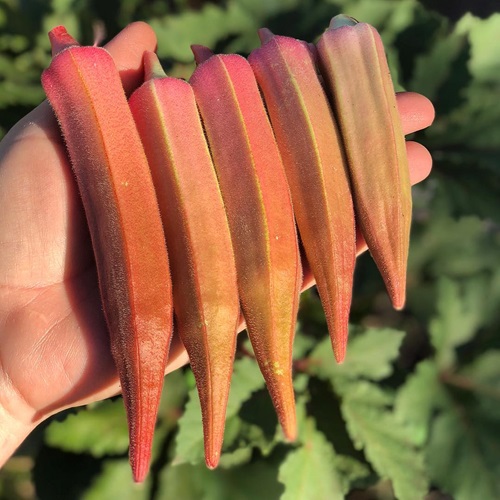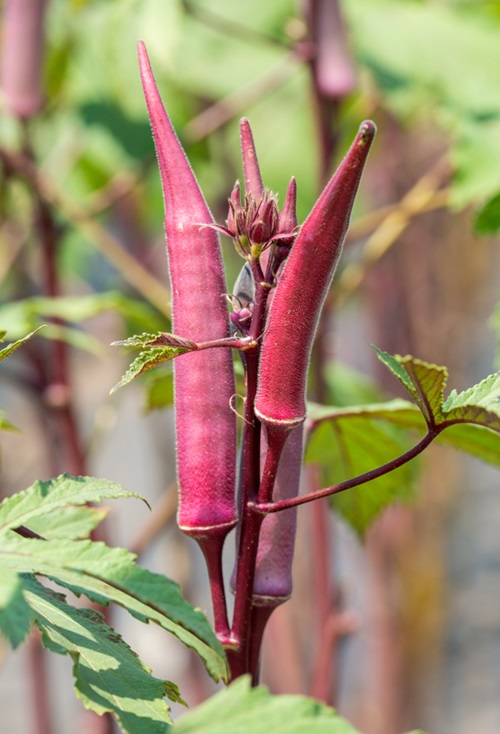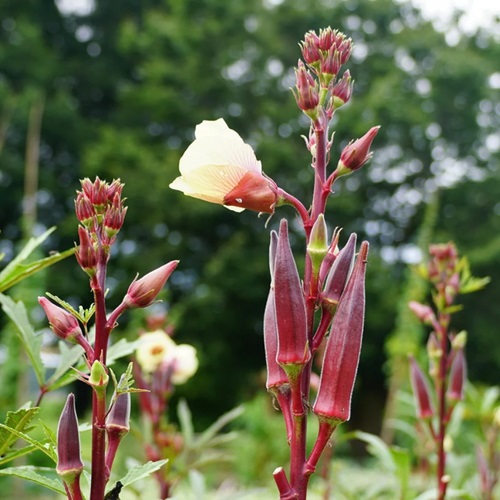Okra offers a colorful palette that can add visual appeal to your garden and variety to dishes! Here are the Different Okra Color Varieties!
From bold burgundies and ravishing reds to unique purples and even captivating oranges, okra offers a rainbow of colors that can add a vibrant twist to both your garden and your plate. Read on to discover Different Okra Color Varieties that can transform your gardening experience and culinary adventures.
Check Best Companion Plants for Okra here
Different Okra Color Varieties
1. Red and Burgundy Okras
Red and burgundy okras are prized not only for their vibrant colors but also for their unique flavors and textures. Below are some popular red and burgundy okra varieties that can add a splash of color to your garden and dishes.
1. Red Burgundy Okra: This is perhaps the most well-known variety in the red and burgundy category. The pods can grow up to 6-8 inches long and are spineless. They turn green when cooked but are a beautiful red hue when raw.
2. Louisiana Red Okra: This variety is particularly well-suited to hot, humid climates. The plants produce deep red pods that are typically about 5 inches long.
3. Little Lucy Okra: Characterized by its dwarf height and striking deep red foliage and pods, this variety is ideal for container gardens. The pods are about 3-4 inches long.
4. Carmine Splendor Okra: This variety boasts deep red, almost crimson, pods that can grow up to 6 inches in length. It is also relatively spineless for easier harvesting.
5. Hill Country Red Okra: Originating from the Texas Hill Country, this variety has red-tinged pods and a unique, nutty flavor. It’s a bit more resistant to drought compared to other okra varieties.
6. Alabama Red Okra: This variety produces long, tapered, and ribbed pods that are a deep red color. The plant itself also has red stems, making it visually appealing in the garden.
2. Purple Okras
Purple okra varieties add a unique visual element to both gardens and culinary dishes, with their striking purple hues setting them apart from the more common green okras.
7. Zarah Okra: This variety is known for its deep, almost black-purple hue. The plant can grow up to 4-5 feet tall, and the pods are generally around 5-6 inches long.
8. Bowling Red Okra: While its name includes ‘red,’ this okra variety actually produces purplish-red pods that are slender and elongated, adding a different shade of purple to the mix.
9. Royal Burgundy: This variety is a darker shade of purple that turns green when cooked. It’s an excellent option if you’re looking for something that’s both ornamental and edible.
10. Star of David Okra: While mostly green, this okra has purple undertones and is often grouped with purple varieties. Its most notable characteristic is its cross-sectional star shape, which is both beautiful and unique.
11. Purple Delight Okra: This dwarf variety produces beautiful purple pods that are about 3-4 inches long, making it ideal for small gardens or container gardening.
12. Red Velvet Okra: While more on the red side, this okra variety often presents with a deep purplish-red hue that is both striking and elegant.
3. Orange Okras

Orange okra is relatively rare compared to its green, red, and purple counterparts, but it offers a stunning visual appeal and unique flavor. While there aren’t as many orange varieties, there are some noteworthy options:
13. Jing Orange Okra: This is one of the most renowned orange okra varieties. Native to Asia, the Jing Orange okra has a light orange hue that matures to a deeper orange as it grows. The pods can grow up to 6 inches long, and the plant itself is well-suited for warm climates.
14. Golden Okra: Though not strictly orange, the golden-yellow color of this variety is close enough to be considered in the orange category by some gardeners. The pods are tender and spineless, making them easier to handle and cook.
15. Burmese Okra: This variety isn’t purely orange but tends to have an orange tint. It’s a highly productive plant, and the pods are often used in Asian cuisines.
16. Louisiana Five-Star Okra: While primarily a green okra, this variety sometimes shows an orange tinge as it matures, particularly when it is exposed to intense sunlight.
4. Green Okras
Green okra is the most common and widely recognized among okra varieties. These plants are not only staples in gardens but also frequent stars in a range of dishes, from stews to stir-fries.
17. Clemson Spineless: This is perhaps the most popular variety, known for its spineless pods that make for easier harvesting and handling. It’s a high-yielding variety with dark green pods.
18. Emerald Okra: This variety produces dark green, spineless pods that are tender and well-suited for cooking. It’s often used in Southern cuisine.
19. Annie Oakley II: This is a dwarf variety that is well-suited for small gardens or containers. Despite its small size, it’s a high-yielding plant with spineless pods.
20. Perkins Long Pod: Known for its long, slightly curved pods, this variety is excellent for dishes that require whole or large slices of okra. It’s also quite resistant to disease.
21. Lee Okra: This variety is prized for its long, slender, and spineless pods. It’s a high-yielding plant and is resistant to some common okra pests.
22. Cajun Delight: A variety that is well-suited for hot and humid climates, Cajun Delight produces medium-length, spineless pods that are excellent for frying.
23. Silver Queen: This variety offers a lighter green color compared to most other green okras. It’s a high-yielding variety that’s resistant to several common okra diseases.
24. Lady Finger Okra: Known for its small, slender pods, this variety is often used in Indian cuisine and is well-suited for quick cooking methods like stir-frying.
25. Dwarf Green Long Pod: As the name suggests, this dwarf plant produces long, green pods. It’s an excellent choice for those with limited gardening space.
Read Malabar Spinach Benefits That’ll Make You Grow It here
Different Okra Color Varieties – FAQs
1. What are the different colors of okra?
Okra is commonly found in green, but it also comes in red, burgundy, purple, and even orange. These unique hues offer aesthetic and nutritional variations that can make your garden and meals more interesting.
2, Do the Different Okra Color Varieties taste different?
Generally, all okra varieties have a similar taste—mildly earthy and slightly sweet. However, some people believe that the red and burgundy varieties are a tad sweeter than their green counterparts.
3. Are Different Okra Color Varieties as easy to grow as green okra?
Most okra varieties, regardless of color, require similar growing conditions—full sun, warm temperatures, and well-drained soil. Some colorful varieties might be less common and could require more specialized care.
4. Can I use Different Okra Color Varieties in traditional okra recipes?
Yes, you can use any color of okra in traditional recipes. The different colors will not significantly affect the taste or texture of the dish but may add a unique visual element.
5. Are there nutritional differences between the different colors?
The nutritional content of okra largely remains the same regardless of color. However, darker colors like red and purple may contain more anthocyanins, a type of antioxidant.
6. Are Different Okra Color Varieties more expensive?
The price of okra may vary depending on factors like availability, demand, and growing conditions. Colorful varieties might be slightly more expensive due to their rarity.
7. Can I find seeds for Different Okra Color Varieties easily?
Seeds for green okra are readily available, but seeds for colorful varieties might require a bit more effort to source. Specialty seed stores or online marketplaces are good places to look.
8. Will colorful okra retain its color when cooked?
The color of some okra varieties may fade when cooked. For instance, red okra often turns green when exposed to heat.
9. Do Different Okra Color Varieties have a longer or shorter shelf life?
The shelf life of okra doesn’t significantly differ based on color. Store okra in the vegetable crisper in your fridge for up to 4 days for optimal freshness.
10. Where can I buy Different Okra Color Varieties?
Colorful okra varieties are often available at farmers’ markets, specialty stores, and sometimes in the organic sections of supermarkets.





